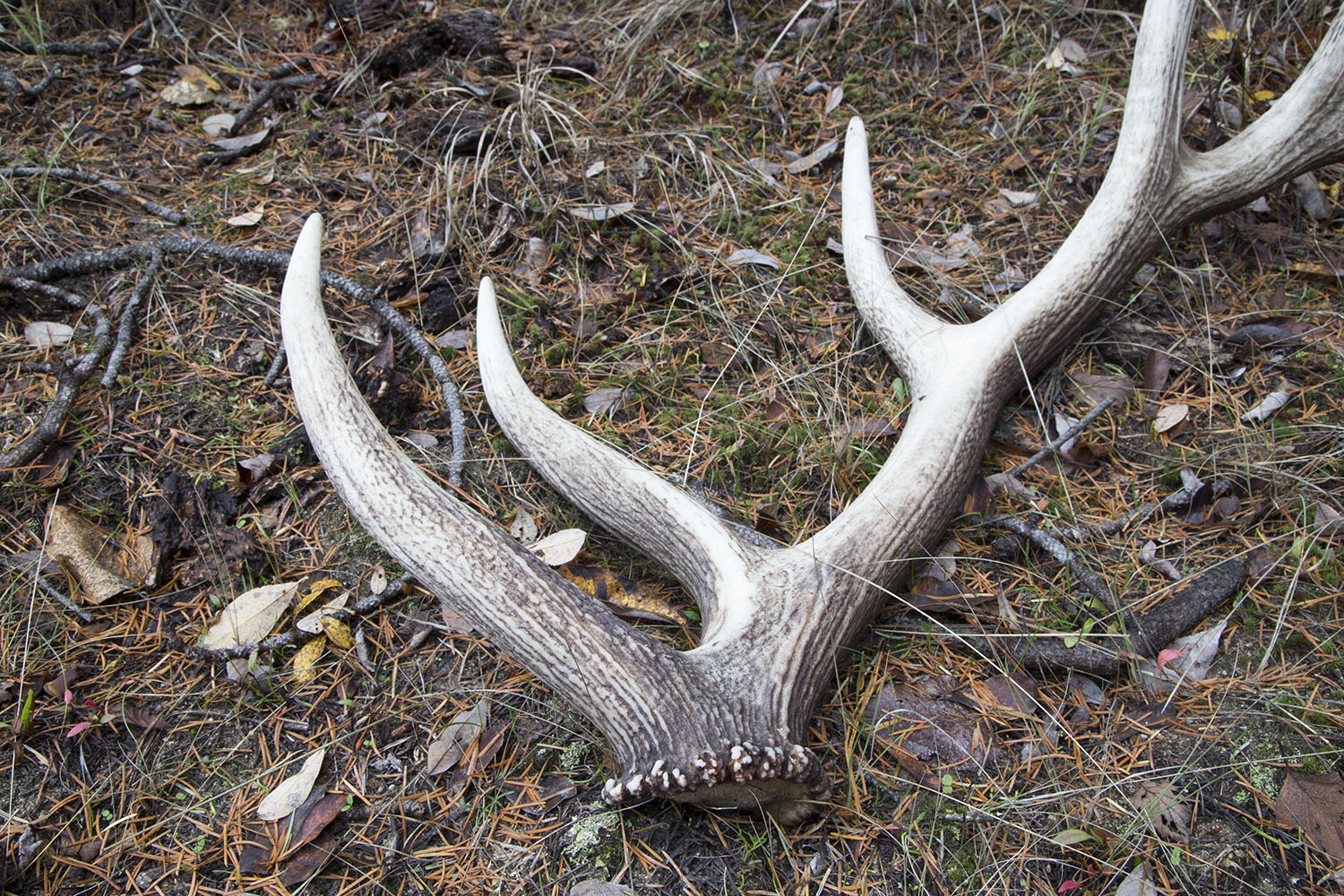Shed Antlers
The possibility of seeing something unusual is one of the draws of being in the outdoors. Taking an object home is another thing- something you can't do in a National Park, but can when visiting National Forests, BLM lands, or state wildlife areas. I can recall looking for mule deer antlers as a six-year old boy on Steens Mountain in southeast Oregon. Something white out in the sagebrush was always worth a look. The pleasure is still there as an adult. Of course the bigger the antler, and the better condition, the better the prize. Elk antlers are a lot bigger than deer antlers, so to find a really big elk antler in near pristine condition excites me a whole lot.
Six point elk antler, as found in the Mission Creek drainage on the Okanogan-Wenatchee National Forest south of Cashmere, Washington.
I have found two large elk antlers in my life-time, one with seven points in the central Idaho mountains in about 1980, and the other a six-pointer from the Mission Creek drainage near Cashmere, Washington in October of 2016. Comparing the two, the Mission Creek antler is far heavier, and from a larger animal.
Comparing the elk antler I found in fall of 2016 near Cashmere, WA with the one I found thirty-five years ago in Idaho, the recent find is much larger. I am going to keep the new one indoors where it won't weather.
Antlers are found through-out the deer family (cervidae) of which elk are a member. With the exception of caribou or reindeer (their domestic equivalent), antlers are borne only by males, and for the purpose of establishing dominance during the breeding season. Deer and elk do not have horns, although "buckhorns" or "elkhorns" are part of popular lexicon. Horns are possessed by cattle, goats, and sheep and are made from a material similar to our fingernails, and are not discarded every year. Antlers are made of bone, and a new set is grown every year.
Elk antlers are shed in February or March, in response to low testosterone levels. Deer antlers are shed earlier. As the spring progresses and days get longer, testosterone levels increase and the animals begin to re-grow their antlers. The growing process in large animals can take 140 to 160 days, and require that they eat seventy pounds of forage per day. Antlers grow out of little nubs on the skull known as pedicels. Initially antlers are fuzzy on the outside, a condition known as "velvet". Inside a rich blood supply delivers phosphorous and calcium for bone growth. The process is enhanced by calcium absorbed into the blood from the skeleton and redistributed to the antlers. By late summer, antlers harden and the velvet peels off in strips, aided by the animals rubbing on brush and trees. The antlers may take on a beautiful brown hue from plant stains.
A bull elk in velvet rests among yearlings, and two calves near Boundary Butte off of Blewett Pass Highway on the Okanogan-Wenatchee National Forest, Washington. I did a long sneak on my belly to get this picture.
A popular fable is that the age of a deer or elk can be determined by the number of antler points. Elk in their second fall of life (fifteen months of age) will typically have a spike or maybe one small branch coming off of the spike. In their third fall, they will have four of five small points. A really large set of antlers comes with an animal of at least six years of age. After about age seven, elk antlers may actually become smaller. The seal, a round disk at the base of the antler is a good indicator of what is to come. If the seal is convex, the animal will grow a larger set of antlers the following year. If the seal is flat the animal has attained its maximum antler size. If the seal is concave antlers the following year will be smaller. Antler size is influenced by age, genetics, and nutrition.
Comparing two elk antlers- the one on the left is from an animal that is at least six years of age, and has maximized its antler size. The antler on the right is probably from an animal approaching three years old when it was shed. The concave shape of the area known as the "seal" indicates the animal will grow larger antlers the following year.
The antler I found in Mission Creek was from an animal in his prime, around seven years old. Knowing that he lived through the fall breeding season, gives me pleasure, as no doubt he sired many calves which are still out in the population. He may be out there still, who knows? Mission Creek falls into Washington Game Management Unit 251, designated as a spike only area for hunting purposes. Wildlife departments have come to realize that hunting focused on taking the largest animals has the effect of reducing the quality of a herd. Spike only hunting does not sound like a bad idea to me from a game management perspective. It also allows more people to see a really large bull elk, and to find a prize shed antler as I did.
Primary Source Material: Wright, James. Developing trophy deer, elk, and antelope. Montana State University Cooperative Extension.




